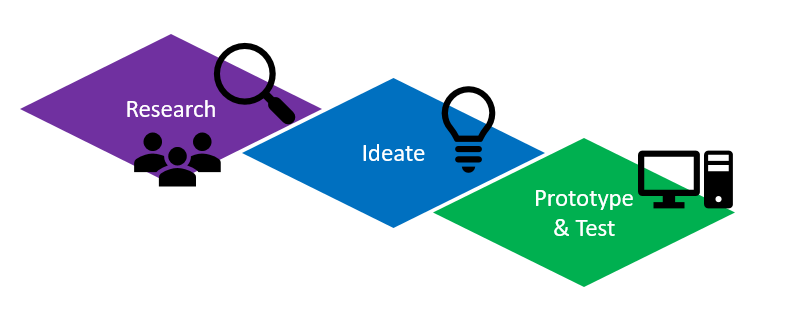
Generally, people are inherently self-focused when it comes to work, driven by questions like ‘What’s in it for me?’ and ‘How does this relate to my situation?’ As a learning designer, my aim is to create impactful and engaging learning experiences. Therefore, I prioritise understanding our users and their needs to ensure relevance and effectiveness from the outset.
What is design thinking?
Do you know what motivates your users? What delights them? What challenges them? What frustrates them? Using design thinking during the design phase will help to answer these questions so that you can tailor your learning solution to your audience’s requirements.
Design thinking uses techniques and tools to get to the heart of the problem. It’s about adopting the mindset of your users, seeing the problem or situation through their eyes, and focusing on solutions that meet their specific needs and wants.
Design thinking process
The below diagram shows the design thinking process and how it involves empathising with users, defining problems, ideating solutions, prototyping, and testing to arrive at innovative and user-centric solutions.
Research stage
Let’s focus on the first stage, the research stage, because I believe that getting to the heart of who the user is, creates the foundation for the design.
Researching involves empathy and defining the problem. It’s a discovery process, where you attempt to identify the explicit and implicit needs of your users so that you can meet them through your design. Place yourself in the users’ shoes and focus on their emotional experience when facing a specific problem. This will also help you to define or reframe the problem you are trying to solve. Sometimes the perceived problem isn’t the actual problem.
But what does this look like in practice? Think about who your solution is aimed at and how they will use it to solve their problem. I start by listing and categorising the different kinds of users. From this list, I then create personas using empathy mapping. It includes information about what the users’ think and feel, such as their fears, their previous experiences, how they learn, and so forth. These personas help to create examples of actual people who will be using the solution.
When you start to collate information from the persona profiles, you will undoubtedly identify commonalities. Use these to guide your design as you move into the ideation phase. Even if you’re only creating a single stand–alone learning module, you can use this knowledge within the module to tap into user motivations.
Ideate stage
The ideate stage in the design thinking process is where the creative energy flows freely. It’s characterised by unbridled brainstorming and idea generation, aimed at exploring a multitude of potential solutions to the defined problem. During this phase, diverse teams come together to pool their insights, experiences, and perspectives, creating a wide range of ideas. Quantity takes precedence over quality at this point, as the goal is to encourage wild and innovative thinking without immediate judgment. These ideas can range from practical and feasible solutions to more radical concepts that push the boundaries. This stage primes the ground for the subsequent stages of prototyping and testing, helping teams to refine and select the most promising solutions that will genuinely address the identified challenge.
Prototyping stage
The prototyping stage is where ideas take tangible form. It involves transforming the selected concepts from the ideation phase into simple, scaled-down representations that can be tested and evaluated. Prototypes can come in various forms, from paper sketches and wireframes to digital mock-ups and physical models, depending on the nature of the design challenge.
The primary purpose of prototyping is to allow designers and users to interact with a visualised version of the solution, facilitating a deeper understanding of its functionality and user experience. This hands-on, iterative process helps uncover potential issues, refine the design, and identify areas for improvement before the full-scale implementation, ultimately resulting in more effective and user-centric solutions.
To sum up
An effective learning design is one that connects to and resonates with your users. This is best achieved through collaboration and empathy. You will gain a perspective of the problem, and bring ideas to life based on how real users think, feel, and behave.
And remember to keep these two top tips in mind to drive design thinking:
- Collaborate: Two heads are better than one. Invite your users to co-create their personas. If possible, formulate the personas through focus groups and interviews.
- Delve deeper: Consider more than just the job role of the user. Explore their daily tasks, motivations, pains etc.
For any questions or to discuss how we can use design thinking to transform your learning experiences, please get in touch.

